7. Hydroculture of ornamental plants
Authors: Máté Ördögh, Márk Steiner
In case of plant cultivation in soil, the following things can cause problems among others: the infectious diseases (for example pathogens, which infects from the soil – Pythium, Rhizoctonia, Fusarium etc. -, from pests, primarily the root knot nematodes), the deteriorated or inappropriate quality soil and the unfavourable environmental impact of the chemical and physical soil disinfection. It was and it is still needed to use more effective growing methods also economically and also environmentally because of the rising price of the energy, the increasing competition, the effort for the higher yield and because of the stricter regulations. The hydroculture systems (there are several types) offer possible solutions for the soil free cultures. But what do we mean under ‘hydroculture’?
7.1. Definition, grouping
In this technology, the cultivation is isolated from the natural soil, in different (mostly artificially produced) media, using solutions, which contains the needed nutrients for the plants’ development; in case of the major ornamental plant cultures (for example: gerbera, rose, carnation) basically under some kind of plant growing structure, practically under glasshouse.
The word ‘hydroculture’ covers several, from each other considerably different growing method. The basic of the grouping, among others are the type of the used medium, how the plants (exactly the roots) situated, the medium containing pots, the utilization of the nutrient solution and the ways of application. The types of the soilless cultivation systems can be summarized according to the table below.
Soilless growing methods (Göhler and Molitor, 2002, modified)
|
1. substrate growing (agroponics) |
1.1. growing in organic medium |
a) thin layer growing |
|
b) bag (slab) growing |
||
|
c) growing in containers |
||
|
1.2. growing in inorganic medium |
a) gravel culture |
|
|
b) growing in rockwool |
||
|
c) growing in perlite |
||
|
d) growing in baked clay pebbles (etc.) |
||
|
2. mediumless growing |
2.1.hydroponics (tank culture, pool growing) |
|
|
2.2. NFT (Nutrient Film Technology) |
||
|
2.3. PPH (Plant Plane Hydroponic) |
||
|
2.4. aeroponics (air- or mist culture) |
||
Open and closed hydroculture systems can be distinguished based on the supply and consumption of nutrient solution. In the first case, the needless solution drains over (mostly directly to the soil, and it helps neither, if the plants grown in a lifted bed, hill, container or stone wool slab). Closed hydroculture is nearly obligate in Western Europe, but also spread in Hungary. In this case the overflow is collected (filtered, sterilized, traced back and reused). Both of them have disadvantages. The unutilized, wasted nutrient solution (especially in case of poor quality irrigation water) is a significant source of environmental pollution. However, the closed systems needed higher technical and professional know-how (greater investment, continuous monitoring), but the environmental rules are getting stricter and allow just this type of hydroponic production.
The type of the medium will be discussed later, further additions needed here about the systems, which can be set up, based on the spatial locations of the roots. According to this, three main groups can be distinguished:
- The roots develop in the air (aeroponics)
- The roots develop in liquid (nutrient solution) (hydroponics)
- The roots develop in tight support media (agroponics)
In case of aeroponics, the roots develop in the air and the nutrient solution is sprayed on them like a mist. The plants don’t have direct or indirect contact with each other (lack of liquid or solid medium), so the infections can be eliminated, it save water and nutrient, but the system is vulnerable and the high technological requirements are also hindering factors. However, it is just an interesting thing, that already in 1983 a type (automated, controlled with microchip and placed on the market) was created (the name was: Genesis Rooting System), which was for facilitate the cuttings in a sterile way, avoid from bacterial infections, for example in case of difficulty rooting woody plants. Not incidental, that this method also has a prominent role for example in space experiments, where the weightlessness raising concerns. Implicitly, it is used mainly for producing food to facilitate the possibility of self-sufficiency, where the plant production is not possible in the traditional ways.
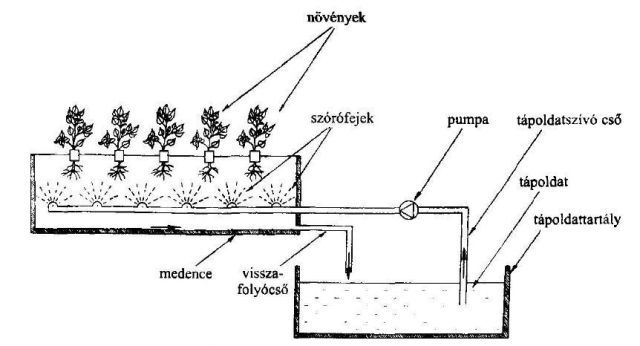
The elements of the aeroponics system (Terbe and Slezák, 2008)
Actually, the hydroponics is the closest to the expression, ‘hydroculture’. In this case the roots developing continuously or periodically (for example flux-reflux irrigation) in a nutrient solution, which contains the necessary macro and micro elements for the development. In a permanent water cover, in an ideal case the oxygenation is ensured by aeration. One of the most important (and may be the best-known) variety is the Nutrient Film Technique (NFT) culture. The kernel of this, that the roots fill the available place, imply into the nutrient solution, which is flowing in a thin layer, in a closed channel, which has an appropriate slope to make possible in this way the gravitation dosing.
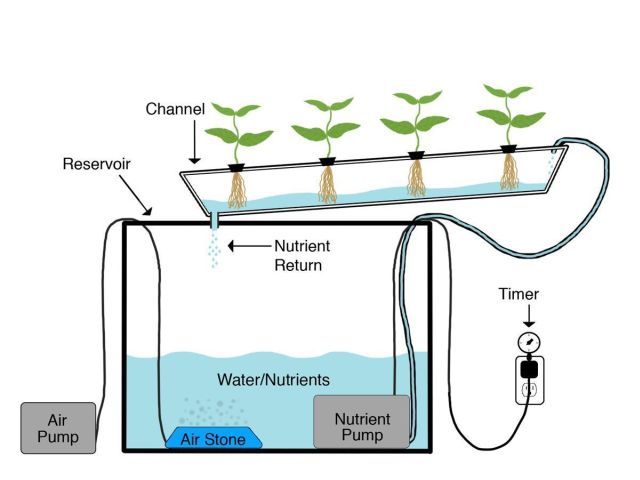
The sketch of the NFT (Nutrient Film Technique)
The PPH (Plant Plane Hydroponic) culture is a transition into the agroponics. In this method the nutrient solution is leaking between two plastic films (mostly the upper one is white to prevent the overheating in summer) in a fleece layer.
In ornamental plant growing, practically just the third group, the agroponics has importance. In this category we can make difference according to two systems, based on the plants’ plantation and location:
a) Individual pot. Here the plants (one or more) placed into 3-10 l soft or hard plastic pot (for example into a foil sack or a container)
Advantage: separable, separated growing, better light utilization, separately can be transported, changeable (can be removed easily if pests appears) plants.
Disadvantage: single frame is needed for the pots, the implementation is more expensive, and precise irrigation system is needed. Cultures, which growing in this way: gerbera, orchids (for example Cymbidium), Anthurium, rose.
b) Slab growing. The slabs are covered by plastic foil, on the bottom has drainage holes and it can be situated on the ground or on trestles. More plants can be planted in the slabs onto or into the holes, which created above. One plant has 0.7-4 l medium.
Advantage: easier, simpler and cheaper implementation, more secure growing.
Disadvantage: infections, diseases can spread more easily (if the symptoms appear in one plant, probably the neighbour plants in the same table are already infected), need to ensure precise overflow (with holes, the number of them is based on the type of the medium: peat, coco: 2 per meter, perlite: 2-3 per meter, stone wool: 1 per meter). Slab cultures: carnation, rose, gerbera, Lisianthus (Eustoma), chrysanthemum.
And if it came up, anyway we need to talk about media, which can support and fix the plants.
7.2. Grouping of the media, short review
In hydroculture growing (because of the topic of this chapter, now we speak about the varieties with tight support medium) use any quantity of medium, because of the economical placement, anyway we need to let just limited space. We need to aim to the quality instead of the quantity. The ideal root fixing medium (beside to not making chemical reaction with the nutrient solution, avoid to change their composition and properties) must be able to contain as much water as possible, what plants can use easily, but also need to be airy.
Used media in the hydroculture has practically just one main function: support appropriate anchor for the roots. Everything else (water, nutrients) need to be added artificially. Media like these, need to be the following:
- The structure need to be stable and degradation-free for a long time
- The water-holding capacity and the hydraulic conductivity need to be appropriate
- Need to be chemically inert (however, it is good if it has buffering effect to some extent)
- It is prerequisite to be pest and pathogen free
Based on the above mentioned things, many different medium can be considered, the grouping about their origin can be the following.
Support mediums, grouped based on their origin (Terbe and Slezák, 2008 )
|
Organic origin |
from miner exploitation |
peat (bogs and uplands) |
|
byproduct of agriculture and plant production |
coir, straw, corn husk, rice peel |
|
|
byproduct of timber and paper industry |
bark, scrapings, sawdust |
|
|
Inorganic (mineral origin) |
it is used without or just with slightly modification after the exploitation |
sand, gravel, ballast, pumice, volcanic tuff, zeolite |
|
Industrially produced (for example treated with high temperature, and with other physical and chemical processes) |
perlite, rockwool, ceramic materials, baked clay pebbles |
|
|
Plastics |
polystyrene, polyurethane, duroplast, polyvinyl chloride |
The peats are one of the most used organic materials. The result of the different environmental changes, which goes on, while its forming, that it has varied structure and composition, and it is also because of the geographical origin, its from plant degradation, and the quantity also depends on the exploitation. In Hungary, in considerable quantity there are just bogs, which are the darker tone type, less acidic, easily compacted (became airless), more humified components contained, occasionally contains sodium in a deteriorative quantity and even can provide significant quantity of N. In case of plant cultivation, the uplands peat has better parameters; it is exploited in considerable quantity in the Northern European regions. The texture of sterile uplands peat is loose, fibrous, mostly it has lighter colour, not compacted even after pressing, can be rewetted better, expressly acid (pH 3-4), poor in nutrients (and in weed seeds). This type also called Sphagnum-peat (it is named from the moss, which are the generation source of this type of peat). Both type of peat mostly not used individually, but mixed with other materials (for example with perlite, bark). The swamps’ exploitation is terminated (lots of them today is preserved area), and because of this the renewable, byproduct materials come into view.
The coir has a high water-holding capacity, it is decomposing slower than the peat, and it is traded compressed to a rectangular shape, in a dried way. With a decent treatment, it is sterile, aseptic and has low EC value. Wider spread (in Hungary) of the coir is hindered because of the necessary treatment (the untreated coir contains high K and Na and it is expedient to reduce with added Ca and Mg) and also because of a relatively high transportation costs.
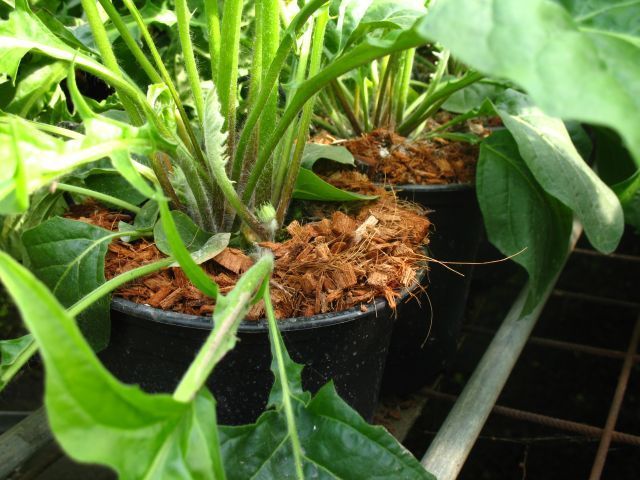
Coir in a natural and in an extruded state
From the mineral origin mediums, the sand is used mostly in propagation, together with other complementary materials (for example peat), it has good air capacity, but has bad water-holding capacity and its physical and chemical features depend on the origin. For cultivation, it is better to use the well leached, preferably about neutral pH river sand (instead of the mine sand, which has more sharp grain surface, it is more clayey and prone to compaction) for example to drain the spare irrigation water or to improve the weight of the medium and the permeability. The gravels (diameter 4-12 mm, or perhaps even bigger), which are much bigger than the grains of sand (0.2-2 mm diameter), and in the same size (mainly basalt) ballast can have role in the hydroponics systems, but rarely because their water-holding capacity is minimal, their structure is not porous and they are heavy. Much more suggested the high porous, light, volcanic originated (andesite, basalt, rhyolite, etc.) tuffs, and pumice in a chopped way, in the same grain size as gravels or ballast. Causative agents could settle down in their pores, in the collected water, so before reusing it is expedient to sterilize (for example with steaming). Zeolite is the crystalline grade of rhyolite tuffs (alkali or alkaline- aluminum silicate), it has large pore surface, cation binding and loosing, it can compensate the nutrient overdose and deficiency, it has a buffering effect. For root fixing it is suggested to use in a bigger grain size than the sand.
Perlite , which is made from rhyolitic volcanic rocks by heating in high (900-1200 °C) temperature, can be easily disinfected. Because of the heating effect, their volume increase for multiple size, it is porous, has low water-holding capacity, white colour and it is slightly crumbling. In ornamental plant cultures - however it is getting more expensive - perlite is used widely (mostly in 3-6 mm grain size), even individually. It is really lightweight, but it is also its disadvantage (it can not give enough stability for the plants). The porous, baked (in high temperature) ceramics, which raw materials’ are clay, sand, feldspar, can be used as a probe for fixing roots, just after conditioning, and well washing-soaking, because of their harmful combustion byproducts. In the cultivation practice the clay pebbles (baked in 1200 °C in a furnace) are used usually in the same size or a bit bigger size like gravel or ballast. It is stable, has small weight, high permeability, porous texture, hard surface, it is chemically neutral, sterile and traded in whole or in crashed way. It has high importance in indoor decoration (for example hydroculture grown ornamental leaf plants in special pots with water level indicator), because of it is pellucid and tractable. It is can be used individually or to cover the medium.
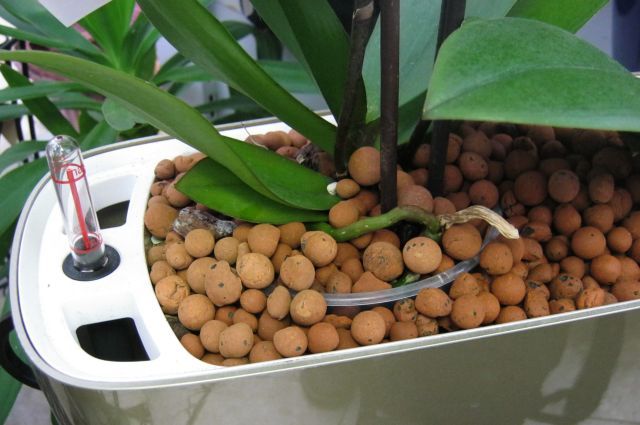
Clay pebbles have high importance in indoor decoration
Continuing the queue of root fixing mediums, which made in high temperature, from all of them, the most important in hydroculture is the stone wool, which compound from chalk, coke and predominantly basalt. Stone wool is agglomerated with resin, it is fibrous, traded diced or in a slab, among others under the name ‘Grodan’, it is sterile, stable, and easily verifiable (pH, EC), the water-air rate is optimal, and it is used often for growing seedlings as well. The seedlings in stone wool cubes, in case of some cultures (for example gerbera, carnation) grow over in slabs, which contain the same material and covered by foil. In this way, the stress of the transplantation can be excluded. However, evidently contribute to increase the yield, make better quality, but it is not reused, so to place the waste can lead to environmental problems. Regards durability, with more densely texture in the top, the Master type slabs has longer lifespan, while Classic-quilts are suggested in 1-2 year cultures and its fibre arrangement is horizontal.
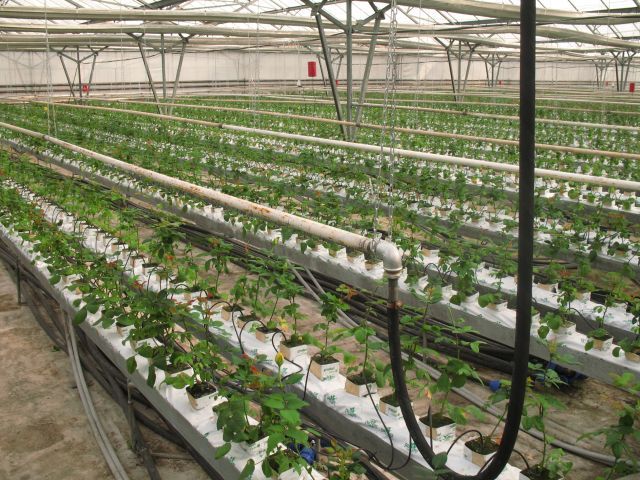
Roses on stone wood slabs
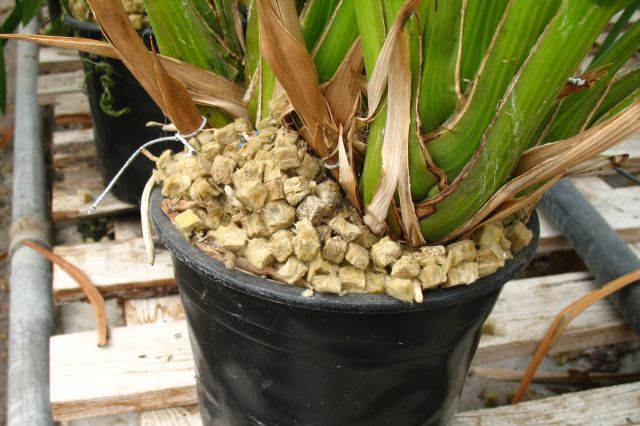
Cymbidium in stone wool cubes in buckets
From plastics, in hydroculture growing we can talk about polyurethane ether (PUR) known as Agrofoam,duroplast (commercial name: Oasis floral foam) polyurethane pieces used mostly in flower arrangement, polyvinyl chloride (PVC) fibres and polystyrene pellets as soilless growing medium. Common characteristics of them are durability, sterility and reliable quality. These kinds of plastics are chemically inert, often water repellent and lightweight. However after the end of the cultivation, their treatment has difficulties similarly as stone wool.
The mediums above, beside the almost exclusive root fixing role, in the creation of the optimal conditions it is necessary to know the characteristics and the control of the water, which is the ‘transporter’ of the necessary nutrients and it is also needed to find the right type of irrigation.
7.3. Water quality requirements, information about the irrigation
Since the hydroculture growing medium that chemically inert, not contain nutrients, therefore the importance of the water (nutrient supply by liquid nutrients as solution) getting significant.
Various relevant parameters of water in case of hydroculture cultivation (Terbe and Slezák, 2008)
|
Characteristics |
Name |
Optimum/limit value |
Notes |
|
Physical |
Temperature |
20-25 °C |
If it is too low: more difficult the nutrient uptake, changing solution-compound (condensing salts) |
|
Quantity of flappy matters |
<50 mg·l-1 |
Can cause fouling (especially at drip irrigation), recommended prefiltration for prevention |
|
|
Chemical |
Salt concentration |
EC: <0.4-1 mS·cm-1 |
Describes well with specific electrical conductivity (EC) |
|
Alkalinity |
HCO3¯ concentration: 40-60 mg·l-1 pH optimum: 5.5-6.5 (slightly acidic), to avoid: pH<5, pH>7 |
The pH is influenced by hydrogen carbonate content, so as certain ions uptake. The pH can be reduced with ion-exchange resins, addition of inorganic acids (e.g. HNO3, H3PO4) or acidifying fertilizer (e.g. NH4NO3). |
|
|
Nutrient content |
From the aspect of irrigation technology, iron and manganese have interest. There is a high risk of getting clogged over 1.5 mg·l-1 concentration. |
Certain micro- and macronutrients ideal concentration is different in plant cultures (Table 4) The iron and manganese content can be reduced with ventilation, oxygenation with potassium permanganate, chlorination but prevention is more profitable. (e.g. acidified nutrient solution) |
|
|
Accompanying ions |
practically every kind of ions plants are cannot be able to uptake |
Not necessarily toxic but redundant ions (e.g. contamination during salinization). Na+ and Cl- exemption can be solved with ion-exchange or reverse osmosis procedure (high costs) |
|
|
Biological |
micro-organizations , mostly from surface or in the near of surface water sources (bacteria, fungi, algae, one-celled animals etc.) |
Although there are among useful presence undesirable, can cause fouling. |
|
Nutrient solution-compound in the hydroculture cultivation of gerbera, rose and carnation
|
Nutrient ( mg·l-1) |
gerbera |
rose |
carnation |
|
N |
175 |
190 |
210 |
|
P |
42 |
50 |
45 |
|
K |
230 |
260 |
280 |
|
Ca |
155 |
160 |
180 |
|
Mg |
30 |
30 |
35 |
|
S |
50 |
40 |
50 |
|
Fe |
2.2 |
2.2 |
2 |
|
Mn |
0.6 |
0.5 |
0.6 |
|
B |
0.4 |
0.3 |
0.35 |
|
Cu |
0.1 |
0.05 |
0.08 |
|
Zn |
0.3 |
0.3 |
0.5 |
|
Mo |
0.05 |
0.05 |
0.05 |
Without solid medium (hydroponics and aeroponics), and especially in closed-cultivation systems has the highest quality standards about water characteristics, but the most common method to dispense nutrient solution in hydroculture, the drip irrigation system itself needs proper preparation of water. Precision dosage assure with higher pressure (2-3 bar), operative pressure regulator units provided systems (lower pressure capillary application can be regulated less), as usual flows of 1-2-4 l·h-1. One or more drippers can be fixed on units, depends on power or current plant culture needs.
Drip irrigation is the most common - cultivate on solid medium almost the only (nutrient solution application) method - however there are several other methods, often depends on the type of hydroculture growing. In case of aeroponics, application of nutrient solution sprinkle, mist emission, in case of NFT-, PPH technique thin layer of nutrient film, depends on possibility of different plant location (e.g. in drain, lobe) sunk, flow, flood, flux and reflux system can be used. Detailed description of every system is not possible here because of the tight range, however the hydroculture growing of some major ornamental plants, need to be mentioned.
7.4. Gerbera
The cultivation of fragile, badly and difficult transportable gerbera did not spread to favourable for climatic ability (subtropical, tropical) areas, significant culture also in Hungary. In the cultivation of gerbera, the knowledge of its environmental needs is essential (summarized in the following table).
Environmental needs of gerbera
|
Temperature |
Light |
Water |
Medium |
Nutrient |
|
Mar-Oct: daytime 18-22 °C, night 14-18 °C Nov-Feb: daytime 14-16 °C, night 10-12 °C soil: all year 20 °C! Soil- and vegetation heating: decreasing fate root (Fusarium, Phytophthora, Botrytis). |
Day length is neutral, but higher luminance more intensive blooming. Summer shading needs because of control temperature and humidity One breeding aim: grow in poor light get more (and good quality) inflorescence varieties |
2000 mm on average a year, in summer even 10 l·m-2 daily. In winter 15 l·m-2 per 2 weeks. Sensitive to slack water! Irrigation water: Minimum 20°C, max. 30 mg·l-1 Na and Cl-content. Relative humidity: 80-90% (after bedding-out), 60-70% (blooming stock) Have to be dried by night! |
pH = 5.5-6 The most common is stone wool (other: peat, coir, additional pine bark, sand, rice peel etc.) |
After bedding-out N-excess (N:P:K = 2:1:1.5) Main growing phase: N:K = 1:1.3 Autumn-Winter: N:K = 1:1.5-1.7 Nitrogen: NH4+ sensible (use: NO3-) EC: 1.5 - 2 Fe and Cu: Sequestren (per 2-4 weeks) In summer weekly foliage fertilizer (1%) CO2: quality improvement (closed room, favourable light condition) |
Hydroculture growing of gerbera results higher yield (increasing 20-30%), better quality, dry lower leaves could stay on the plants for longer time (saving workforce), minimal root mould risk, but require higher investments and precise technology. The culture takes 1-3 year time (from the 2 nd year, the blossom quality decreasing).
Propagation material from micropropagation is growing on stone wool cubes, Jiffy coco blocks and after 4-8 weeks, in 5-6 leaves condition put them on stone wool slabs or containers (see main parameters in table below). Work with cultivation (irrigation-nutrient application, breakin first buds, remove specific leaves, plant protection) and flower picking are quite same as general growing, so do not discussed specifically here.
Data of gerbera on slab and in containers
|
System |
Slabs (Figure 5) |
Containers (Figure 6) |
|
Plantholder |
quilt cover by white foil (10-20 x 7.5-15 x 100 cm) |
Plastic container 3l |
|
Number of plants in holder |
4 plants per slab |
1 plant per container |
|
Placement |
Twin rows on grid, drain, cordon system |
|
|
Type of medium |
Stone wool |
stone wool (cubes with 1-2 cm edges, Figure 7), coco discs in water |
|
Amount of medium |
15-20 l·m-2 |
18 l·m-2 |
|
Medium density |
65-80 kg·m-3 |
75 kg·m-3 |
|
Planting density |
6-7 plants per m2 |
6 plants per m2, min. 50 cm spacing |
|
Planting method |
place on the top of medium (root collar never be under surface) |
|
|
Planting time |
Mar-Jul. (blossoming start: from late Autumn to Spring) |
|
|
Irrigation method, amount |
drip irrigation (6 drippers per m2), 1 l·h-2 |
|
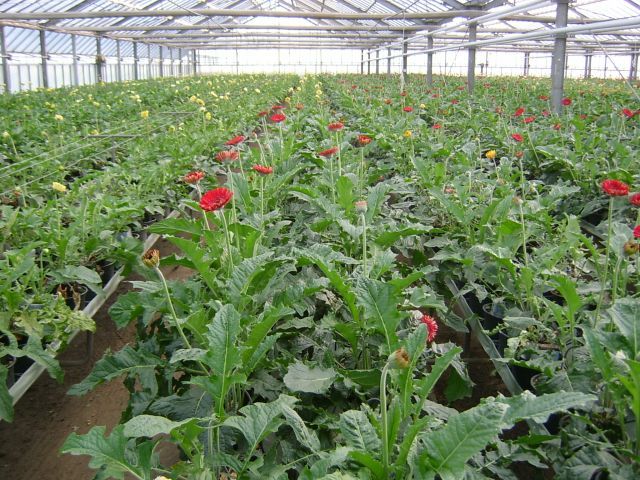
Gerbera in containers system (scheme)
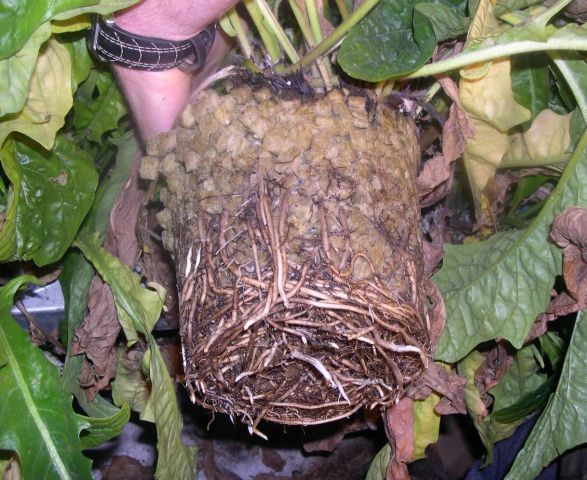
Strong roots of gerbera grown in stone wool cube
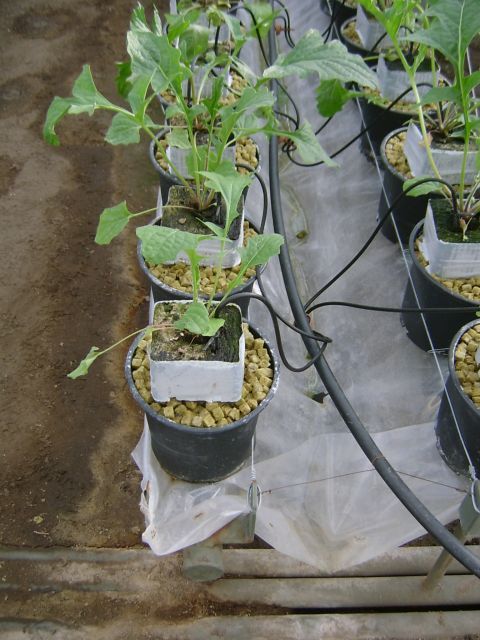
Locating cubed seedlings gerbera enough to put on the top of growing surface
7.5. Rose
Growing of cut roses spreading to areas of cheap workforce, favourable environmental conditions and ever so popular in Hungary (in first place of popular plants in Europe too), especially in autumn-winter months, Hungary cannot compete with African (Kenya, Ethiopia) import. However, it is useful to review the facts of hydroculture growing and needs. In the table below can see shortly the aspects of growing.
Environmental needs of rose
|
Temperature |
Light |
Water |
Medium |
Nutrient |
|
Low heat demand at daylight: 16-18 °C, at night 14-16 °C Over 25 °C quality declining. Wintering growing spread again (relaxing at 5-8 °C) |
Light-demanding! Really important for blooming formation (till after 4-5weeks) otherwise the shoot goes "blind" (not developing bud) At wintertime assimilation lighting needs (high costs) |
High water demand 1 m3·m-2 per year Salt sensitive, softened water, rain water the best for humidify (after planting 80%, later 60-70% humidity) |
pH=6 Rose likes table structured, hard ground medium Hydroculture: stone wool, occasionally coir |
Need continuous, consistent nutrient supply EC: 1.5-2 More sensitive for Na- and Cl- than the other ornamental plants (Na<25 mg·l-1, Cl<50 mg·l -1) Optimal: N:P:K = 1:0.4:1.2-1.5 |
Relevant data and information of rose hydroculture cultivation
|
Planting, timing of culture |
Planting density |
Medium, system, irrigation |
|
Timing: end of Jun. - beginning of Jul. Method: put on the surface of medium Material: rooted cutting or grafted in hand, rooting in rock wool Cultivation time 3-5 years (not economic after, quick changing of varieties) |
High (8-10 plants per m2): Plenty of shoots (must pruning, difficult to work between them), worse quality Medium (6-7 plants per m2): Good quality, average yield Low (5 plants or less) really good quality, low yield |
Quantity of medium: 12-18 l·m-2 Density of medium: 65-80 kg·m-3 Rock wool (15-20 x 7.5 x 100 cm slab, 6-7 plants per slab) Coir (3 plants per a 8-10 l bucket, container) Irrigation: dripping (4-8 drippers per m2; 1 l·h-2) System: twin rows on stable cordon system, height 40-50 cm, in strong edged drain |
In hydroculture of rose bending down (Japanese) method is the most popular from 1990 in Europe, 1996 in Hungary. In this method actually two levels (assimilation and blooming) get developing (Figure 9 and 10). The mass of bended down and pinched out shoots gives enough green space for adequate quantity and quality of blooming, because long, strong and ideal for cutting shoots developing on curves of bended parts. Rose needs a plenty of phytotechnical work (first buds pinching out, shoots bending, side shoots removing, blind shoots removing, blooming level breeding, older assimilative parts removing and replacing etc.) but with these methods achievable 40-50 % yield increasing. The cultivation has basically two types of planting and shoot-trimming with their advantages and disadvantages too, even the rose growers not sure which type is the ideal. We are not discussing here about flower picking and plant protection, these topics are more described in the chapter of rose general growing.
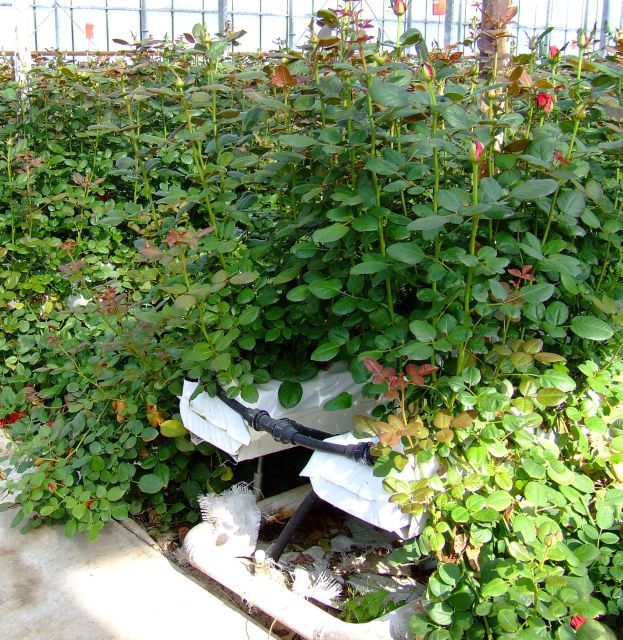
Rose stock grown with bending down method

the work and the plant protection is easier, stronger shoots developing,
but the light usability is less, the climate control is more difficult, and it is vulnerable

it is more difficult to access, because the shoots reach each other,
but it has better light usability and has integrated stock climate
Slab system of rose
7.6. Carnation
Cut carnation used to be on the 1-2nd place (today about the 4-5th place) in growing in Hungary, but also Europe-wide more and more the interest is relapsing (as the growing areas relapsing to Mediterranean areas), however carnation is still one of the most important culture. The basic needs of the plant are shown in the following table.
Environmental needs of carnation
|
Temperature |
Light |
Water |
Medium |
Nutrient |
|
At cutting: 16-20 °C Growing: in summer 20-22 °C (over 24 °C slowing down) Winter daily optimum 12 °C (min. 10 °C, max. 16 °C), night 6-8 °C Permanent cold, high thermal fluctuation: sepal rupture, too high: speed up, but worse quality |
Light-demanding! Influence the time required to blooming (light values of Aicardi: every month has the competent part time units, take these summation and based on this after the 1x heading back 22, after 2x heading back 20 units expect the blooming) |
Regular, consistent water supply needs (800-900 l·m-2 per year) It grows roots on shallow level, so irrigate often but with less dose Winter: water needs preheating Water can never reach the leaves! |
pH = 6-6.5 Well drainage needs At hydroculture used usually stone wool |
EC: 1.7-2.2 Nutrient demanding, especially N, K and Ca-needs high (80-110, 100-150 and 50 g·m-2 per year) Little bit Cl-sensitive |
Usually carnation is grown in stone wool slab system for 1-2 years (see growing parameters in table below)
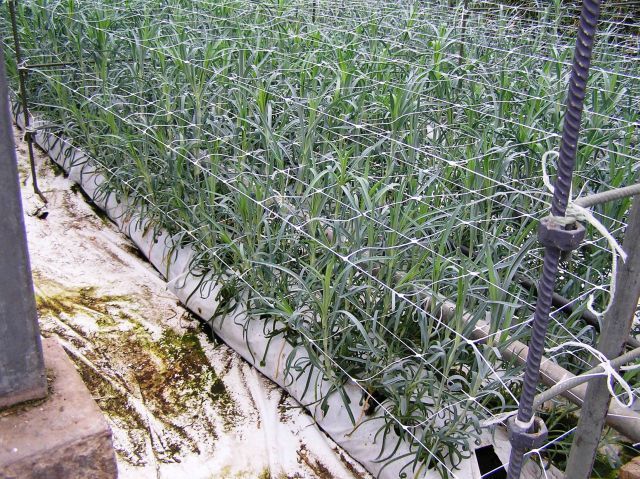
Before blooming carnation stock in slab system
|
Planting |
Planting density, medium |
System, location, irrigation |
|
Time: between Feb-Jun. Method: sunk into medium Material: rooted cutting grown in perlite, peat (Jiffy) or stone wool |
16-25 plants per m2 6-18 plants per slab (Figure 13) Quantity of medium: 15-20 l·m-2 Density of medium: 50-65 kg·m-3 |
15-20 x 7.5 x 100 cm slabs Location: directly on the ground, in overflow-collect drain Irrigation: linear or drip (4 drippers per slab) |
The phytotechnical works (breaking back, netting, interleafing, budding etc.), flower picking, plant protection are not discussed here, these topics are more described in the general description of carnation growing.
7.7. Cymbidium
Rich colour palette Cymbidium hybrids (as cut flower) significance is non-negligible. Its growing more economical because of the main blooming is in winter in Hungary, has low heat-demand (high yield in point of per unit of surface).
Environmental needs of Cymbidiums
|
Temprature |
Light |
Water |
Medium |
Nutrient |
|
At vegetative growing: 18-20 °C Vernalization: 14-16 °C (till freezing-point) Blooming: 16-18 °C (higher: bud damage and necrosis) |
Light demanding, but in Apr-Sep months needs shading |
Water demanding and humidity demanding too (drip irrigation, 2-4 drippers per pot) |
pH = 5-5.5 Good drainage, loose medium required Pine bark is the most significant supplementary In hydroculture mostly stone wool+agrofoam mixture, stone wool cubes, perlite |
EC: 1.2-1.7 Vegetative growing: N:P:K = 1.5:1:1 Vernalization: 1.2:0.7:1.2 Bud developing, blossoming: 1.8:1.5:2 Dormancy: ø |
Cymbidium s are dynamic, robust plants with big growing area (1-2 plants per m2). Its propagation comes from pseudobulbs in pots. After nursing the cut orchids growing continues in big sized, 18-25 l strong, hard and closed wall pots, buckets even technically solvable in polytunnels. After the intensive shoot developing term (from spring till middle of summer), cold needs for bloom developing. Cold needs in July-August for early varieties blooming from September, normal cold for blooming from December-February and cold needs late varieties in autumn. Inflorescence are fixed with plastic hooks, rubber bands, cut could happen from stool depends on claim from closed top buds to full opened blossoms, packed into crystal poly foil clustered or boxed per each flower.
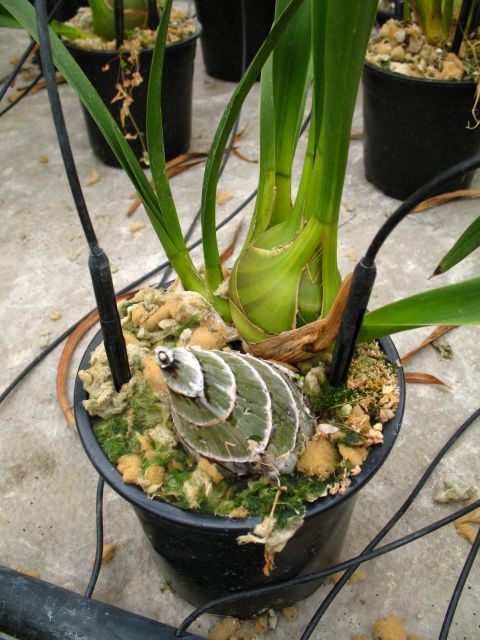
Cymbidium -pseudobulbs and young plants
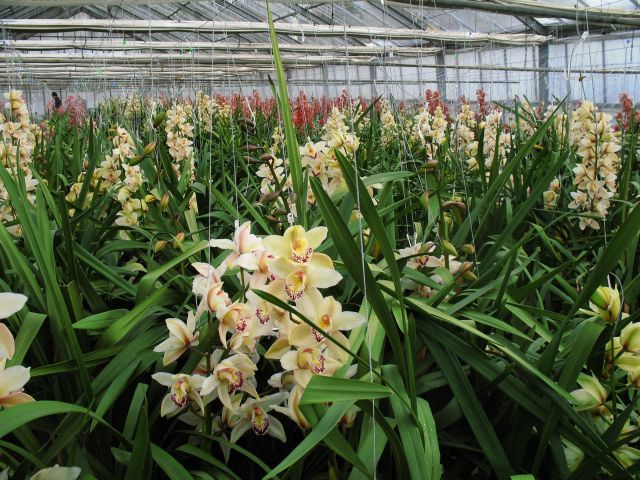
Cymbidium hybrids
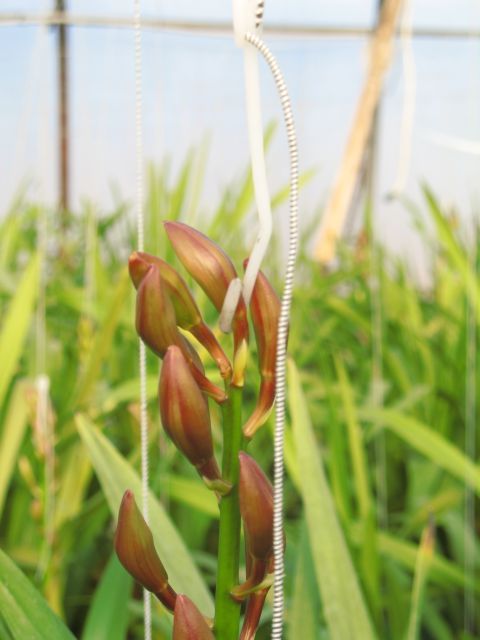
Cymbidium inflorescence
Recommended literature
- Chris B. (2003): Ball Redbook – Greenhouses and Equipment. Volume 1. Ball Publishing, Batavia
- Debbie H. (2003): Ball Redbook – Crop Production. Volume 2. Ball Publishing, Batavia
- Göhler, H., Molitor, H. (2002): Erdlose Kulturverfahren im Gartenbau. Eugen Ulmer GmbH & Co, Stuttgart
- Kovács A. (1998): Vízkultúrás palántanevelés technológiája. Zöldség, dísznövény és szamóca vízkultúrás termesztési tanfolyam. Budapest, Kertészeti és Élelmiszeripari Egyetem, Zöldségtermesztési Tanszék
- Kovács A. (2000): Talaj nélküli termesztés. 100-120. p. In: Balázs. S. (szerk.): A zöldséghahjtatás kézikönyve. Budapest, Mezőgazda Kiadó
- M. Edward Muckle (1994): Basic Hydroponics – for the do-it-yourselfer. Growers Press Inc., Princeton, British Columbia, Canada
- Mihal Đ., Branka L., Anđelko B., Agnes P., Vladan M., Žarko, I., Vida T. (2009): Zöldségfélék és dísznövények termesztése fedett területen. Thurzó Lajos Közművelődési Központ, Zenta
- Stoner, R.J (1983). Rooting in Air. Greenhouse Grower Vol I No. 11
- Szőriné Z. A. (1999): A kőgyapot, mint a vízkultúrás termesztés általánosan elterjedt közege. Tápoldatozás és a vízkultúrás termesztés ABC-je. Budapest, Kertészeti és Élelmiszeripari Egyetem, Zöldségtermesztési Tanszék
- Szőriné Z. A. (1999): Kultúraváltás. Grodan Információs Újság
- Tarjányiné S. Zs. (1980): Zöldséghatjtatás talaj nélkül – tápoldattal. Hajtatás Korai Termesztés 11 (2) 13-16. p.; 11 (3): 13-15. p.; 11 (4): 9-12. p.
- Terbe I., Slezák K. (2008): Talaj nélküli zöldséghajtatás. Mezőgazda Kiadó, Budapest (http://www.scribd.com/doc/52158776/Talaj-nelkuli-zoldseghajtatas-2008-BW)
- Tompos Dániel: A kőzetgyapotos paprikahajtatás egyes technológiai elemei és ökonómiai összefüggései. Doktori értekezés. Budapest, 2006. (http://phd.lib.uni-corvinus.hu/19/1/tompos_daniel.pdf)

